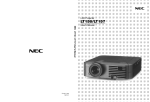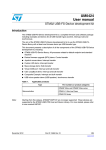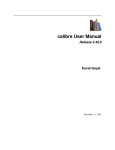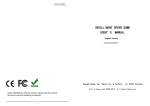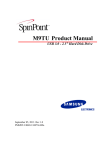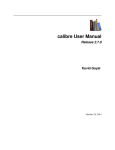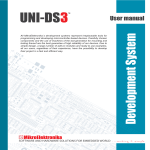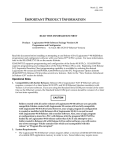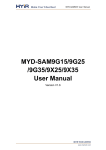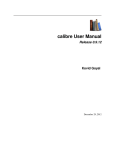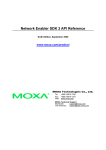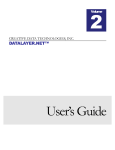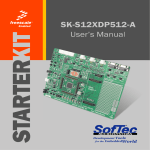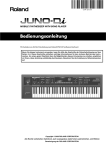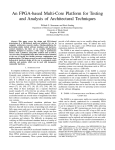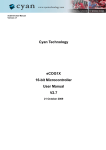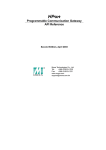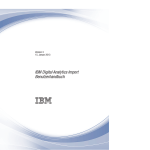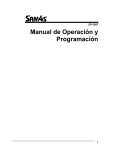Download DRM065, USB2.0 Card Reader Designer
Transcript
USB2.0 Card Reader Designer Reference Manual MC9S12 Microcontrollers DRM065 Rev. 0.1 01/2005 freescale.com USB2.0 Card Reader Designer Reference Manual by: Dennis Lui Derek Lau Application Engineering Microcontroller Division Hong Kong To provide the most up-to-date information, the revision of our documents on the World Wide Web will be the most current. Your printed copy may be an earlier revision. To verify that you have the latest information available, refer to http://www.freescale.com The following revision history table summarizes changes contained in this document. For your convenience, the page number designators have been linked to the appropriate location. Revision History Date Revision Level 01/2005 0.1 Description Initial release Page Number(s) N/A MC9S12UF32 Card Reader Reference Design User Manual, Rev. 0.1 Freescale Semiconductor 3 Revision History MC9S12UF32 Card Reader Reference Design User Manual, Rev. 0.1 4 Freescale Semiconductor Contents Chapter 1 System Overview 1.1 1.2 1.2.1 1.2.2 1.3 1.3.1 1.4 1.4.1 1.4.2 1.4.3 1.4.4 Introduction . . . . . . . . . . . . . . . . . . . . . . . . . . . . . . . . . . . . . . . . . . . . . . . . . . . . . . . . . . . . . . . . . System Features . . . . . . . . . . . . . . . . . . . . . . . . . . . . . . . . . . . . . . . . . . . . . . . . . . . . . . . . . . . . . System Features . . . . . . . . . . . . . . . . . . . . . . . . . . . . . . . . . . . . . . . . . . . . . . . . . . . . . . . . . . Cards Supported . . . . . . . . . . . . . . . . . . . . . . . . . . . . . . . . . . . . . . . . . . . . . . . . . . . . . . . . . . MC9S12UF32 Features . . . . . . . . . . . . . . . . . . . . . . . . . . . . . . . . . . . . . . . . . . . . . . . . . . . . . . . . MC9S12UF32 feature List . . . . . . . . . . . . . . . . . . . . . . . . . . . . . . . . . . . . . . . . . . . . . . . . . . . System Overview . . . . . . . . . . . . . . . . . . . . . . . . . . . . . . . . . . . . . . . . . . . . . . . . . . . . . . . . . . . . . Voltage Regulation. . . . . . . . . . . . . . . . . . . . . . . . . . . . . . . . . . . . . . . . . . . . . . . . . . . . . . . . . Background Debug Interface . . . . . . . . . . . . . . . . . . . . . . . . . . . . . . . . . . . . . . . . . . . . . . . . . USB Interface. . . . . . . . . . . . . . . . . . . . . . . . . . . . . . . . . . . . . . . . . . . . . . . . . . . . . . . . . . . . . Memory Cards Interfaces. . . . . . . . . . . . . . . . . . . . . . . . . . . . . . . . . . . . . . . . . . . . . . . . . . . . 7 7 7 7 7 8 8 9 9 9 9 Chapter 2 Hardware 2.1 2.2 2.3 Introduction . . . . . . . . . . . . . . . . . . . . . . . . . . . . . . . . . . . . . . . . . . . . . . . . . . . . . . . . . . . . . . . . 11 M68EVB912UF32 . . . . . . . . . . . . . . . . . . . . . . . . . . . . . . . . . . . . . . . . . . . . . . . . . . . . . . . . . . . 11 Modifications . . . . . . . . . . . . . . . . . . . . . . . . . . . . . . . . . . . . . . . . . . . . . . . . . . . . . . . . . . . . . . . 12 Chapter 3 Software Overview 3.1 System Software Architecture . . . . . . . . . . . . . . . . . . . . . . . . . . . . . . . . . . . . . . . . . . . . . . . . . . 3.2 Main Software Flow . . . . . . . . . . . . . . . . . . . . . . . . . . . . . . . . . . . . . . . . . . . . . . . . . . . . . . . . . . 3.2.1 Main Program. . . . . . . . . . . . . . . . . . . . . . . . . . . . . . . . . . . . . . . . . . . . . . . . . . . . . . . . . . . . 3.2.1.1 USB Events Handler. . . . . . . . . . . . . . . . . . . . . . . . . . . . . . . . . . . . . . . . . . . . . . . . . . . . . 3.2.1.2 USBMS Events Handler . . . . . . . . . . . . . . . . . . . . . . . . . . . . . . . . . . . . . . . . . . . . . . . . . . 3.2.1.3 Card Insertion and Removal Handler . . . . . . . . . . . . . . . . . . . . . . . . . . . . . . . . . . . . . . . . 3.2.2 Timer Interrupt . . . . . . . . . . . . . . . . . . . . . . . . . . . . . . . . . . . . . . . . . . . . . . . . . . . . . . . . . . . 3.2.3 USB Interrupts . . . . . . . . . . . . . . . . . . . . . . . . . . . . . . . . . . . . . . . . . . . . . . . . . . . . . . . . . . . 3.3 Memory Mapping . . . . . . . . . . . . . . . . . . . . . . . . . . . . . . . . . . . . . . . . . . . . . . . . . . . . . . . . . . . . 13 14 14 14 14 14 15 15 15 Chapter 4 USB Module 4.1 4.2 4.3 4.4 Introduction . . . . . . . . . . . . . . . . . . . . . . . . . . . . . . . . . . . . . . . . . . . . . . . . . . . . . . . . . . . . . . . . Endpoints Configurations . . . . . . . . . . . . . . . . . . . . . . . . . . . . . . . . . . . . . . . . . . . . . . . . . . . . . . USB Device Requests . . . . . . . . . . . . . . . . . . . . . . . . . . . . . . . . . . . . . . . . . . . . . . . . . . . . . . . . Initialization the USB Module . . . . . . . . . . . . . . . . . . . . . . . . . . . . . . . . . . . . . . . . . . . . . . . . . . . 17 17 17 18 MC9S12UF32 Card Reader Reference Design User Manual, Rev. 0.1 Freescale Semiconductor TOC-5 Chapter 5 Intelligence QUEUE Module 5.1 5.2 Introduction . . . . . . . . . . . . . . . . . . . . . . . . . . . . . . . . . . . . . . . . . . . . . . . . . . . . . . . . . . . . . . . . 19 IQUEUE Request Mapping . . . . . . . . . . . . . . . . . . . . . . . . . . . . . . . . . . . . . . . . . . . . . . . . . . . . 19 Chapter 6 USB Mass Storage Driver 6.1 Introduction . . . . . . . . . . . . . . . . . . . . . . . . . . . . . . . . . . . . . . . . . . . . . . . . . . . . . . . . . . . . . . . . 6.2 USB Mass Storage Class Bulk-Only Transport . . . . . . . . . . . . . . . . . . . . . . . . . . . . . . . . . . . . . 6.2.1 USB Command Block Wrapper . . . . . . . . . . . . . . . . . . . . . . . . . . . . . . . . . . . . . . . . . . . . . . 6.2.2 USB Command Status Wrapper . . . . . . . . . . . . . . . . . . . . . . . . . . . . . . . . . . . . . . . . . . . . . 6.2.3 SCSI Command Descritpor Block . . . . . . . . . . . . . . . . . . . . . . . . . . . . . . . . . . . . . . . . . . . . 6.2.4 Example of Command Block Wrapper . . . . . . . . . . . . . . . . . . . . . . . . . . . . . . . . . . . . . . . . . 6.3 Driver Structure . . . . . . . . . . . . . . . . . . . . . . . . . . . . . . . . . . . . . . . . . . . . . . . . . . . . . . . . . . . . . 6.3.1 Handling of USB Command Block Wrapper . . . . . . . . . . . . . . . . . . . . . . . . . . . . . . . . . . . . 6.3.1.1 Commands Without Data Transfer. . . . . . . . . . . . . . . . . . . . . . . . . . . . . . . . . . . . . . . . . . 6.3.1.2 Host Sends out Data to Storage Device. . . . . . . . . . . . . . . . . . . . . . . . . . . . . . . . . . . . . . 6.3.1.3 Host Receives Data from Storage Device. . . . . . . . . . . . . . . . . . . . . . . . . . . . . . . . . . . . . 6.3.2 Class Specific Request . . . . . . . . . . . . . . . . . . . . . . . . . . . . . . . . . . . . . . . . . . . . . . . . . . . . 21 21 22 23 23 25 25 25 26 26 26 28 Chapter 7 Memory Cards Mass Storage Drivers 7.1 7.2 7.3 7.4 7.4.1 7.4.2 7.4.3 Introduction . . . . . . . . . . . . . . . . . . . . . . . . . . . . . . . . . . . . . . . . . . . . . . . . . . . . . . . . . . . . . . . . RAM Mapping . . . . . . . . . . . . . . . . . . . . . . . . . . . . . . . . . . . . . . . . . . . . . . . . . . . . . . . . . . . . . . Windows File Systems and MS/SM Data Format . . . . . . . . . . . . . . . . . . . . . . . . . . . . . . . . . . . Memory Card Mass Storage Drivers . . . . . . . . . . . . . . . . . . . . . . . . . . . . . . . . . . . . . . . . . . . . . Commands Without Data Transfer. . . . . . . . . . . . . . . . . . . . . . . . . . . . . . . . . . . . . . . . . . . . Host Sends out Data to card reader. . . . . . . . . . . . . . . . . . . . . . . . . . . . . . . . . . . . . . . . . . . Host Receives Data from Card Reader.. . . . . . . . . . . . . . . . . . . . . . . . . . . . . . . . . . . . . . . . 29 29 29 31 31 31 32 Chapter 8 Testing and Customization 8.1 Introduction . . . . . . . . . . . . . . . . . . . . . . . . . . . . . . . . . . . . . . . . . . . . . . . . . . . . . . . . . . . . . . . . 8.2 Customization . . . . . . . . . . . . . . . . . . . . . . . . . . . . . . . . . . . . . . . . . . . . . . . . . . . . . . . . . . . . . . 8.2.1 Hardware . . . . . . . . . . . . . . . . . . . . . . . . . . . . . . . . . . . . . . . . . . . . . . . . . . . . . . . . . . . . . . . 8.2.2 Firmware . . . . . . . . . . . . . . . . . . . . . . . . . . . . . . . . . . . . . . . . . . . . . . . . . . . . . . . . . . . . . . . 8.2.2.1 UF32 Card Reader Project . . . . . . . . . . . . . . . . . . . . . . . . . . . . . . . . . . . . . . . . . . . . . . . . 8.2.2.2 Mini-Kernel Project . . . . . . . . . . . . . . . . . . . . . . . . . . . . . . . . . . . . . . . . . . . . . . . . . . . . . . 35 35 35 35 35 35 Chapter 9 Glossary MC9S12UF32 Card Reader Reference Design User Manual, Rev. 0.1 TOC-6 Freescale Semiconductor Chapter 1 System Overview 1.1 Introduction This manual describes a reference design of a Universal Serial Bus Card Reader solution by using the MC9S12UF32. The software was developed under the M68EVB912UF32 evaluation platform board. Some hardware modifications are required in order for the software to be used under the board. The firmware source codes are available as reference materials. 1.2 System Features 1.2.1 System Features • • • USB 2.0 High Speed and Full Speed Compliance. Windows 98 SE, Windows 2000 and Windows XP Compatible In Circuit Evaluation and Programming 1.2.2 Cards Supported • • • • • • • CompactFlash Card (Type 1 and II) Memory Stick Memory Stick Duo Magic Gate Secure Digital MultimediaCard SmartMedia 1.3 MC9S12UF32 Features The MC9S12UF32 microcontroller (hereafter referred as UF32) features an integrated Universal Serial Bus (USB) 2.0 controller and physical layer transceivers to provide comprehensive USB specification implementation for both high-speed (480 Mbps) and full-speed (12 Mbps) operations. The high-speed operation, running at bus speed of 30 MHz, implements fast large data transfers for applications such as real-time movies that were impractical at the previous lower-speed operation. Besides standard USB functionality, the UF32 enables control of external hard disk drives, CD-ROM and DVD-ROM drives. The UF32 also enables controls of different common Flash memory devices including: CompactFlash, Secure Digital, MultiMediaCard, SmartMedia and Memory Stick memory cards. The availability of up to 75 programmable I/O lines helps to minimize the system costs and enhance flexibility. MC9S12UF32 Card Reader Reference Design User Manual, Rev. 0.1 Freescale Semiconductor 7 System Overview The UF32 is designed to reduce overall system components count and to improve performance by off-loading peripheral overhead functions from the CPU. The on-board Flash enables the peripheral system to accommodate future software upgrades. The UF32 can be used in card readers for popular Flash memory cards, ATA/ATAPI bridges for external hard disks and DVD ROM, USB Flash disks and digital wallets. There are 100-pin and 64-pin options for the UF32. The 100-pin device is designed for card reader and digital wallet applications while the 64-pin device is designed for ATA/ATAPI bridge with SD access or USB applications with SM, SD and MS access, and other USB applications that do not require so many I/O pins. 1.3.1 MC9S12UF32 feature List • • • • • • • • • • • HCS12 core 32K Bytes Flash, 3.5K Bytes RAM, 1.5K Bytes Queue RAM Universal Serial Bus 2.0 controller and transceivers Integrated Queue controller ATA/ATAPI Host controller CompactFlash Host controller Secure Digital and MultiMediaCard Host controller SmartMedia and NAND Flash Host controller Memory Stick Host controller 8-channel, 16-bit timer Serial Communications Interface 1.4 System Overview 5V VDDA MC9S12UF32 5V VDDR 5V 3.3V 2.5V USB REG 2.5V REF3V PORTE BDM USB PORTQ PORTP 3.3V VDD3X 3.3V 5/3.3V VDD SM PORTM SD/MMC PORTJ MS PORTT S12 Core PORTU PORTS PORTR CF PORTB VDDX 5/3.3V PORTA Figure 1-1. Block Diagram MC9S12UF32 Card Reader Reference Design User Manual, Rev. 0.1 8 Freescale Semiconductor System Overview Since the UF32 is a highly integrated high-speed USB 2.0 device with embedded CF, MS, SD/MMC and SM host controllers, the major components to implement a card reader include only a UF32, a MOSFET for 3.3V regulation and the memory cards sockets. The system functions can be divided into the following parts. • Voltage regulation • Background debug interface • USB interface • Memory card interfaces 1.4.1 Voltage Regulation The UF32 is designed for a single 5V voltage input. There are three kinds of I/O: • Port E of 5V I/O • Port J, M, P and Q of 5V or 3.3V I/O powered by VDD3X • Port A, B, R, S, T and U of 5V or 3.3V I/O powered by VDDX For UF32 used in card reader applications VDDX and VDD3X are set to 3.3V. Therefore, only the Port E is with 5V I/O while the others are with 3.3V I/O. The UF32 has got four built-in regulators: • 2.5V regulator for S12 core use • 2.5V regulator for USB transceiver use • 3.3V regulator for USB transceiver and PLL use • 3.3V regulator that needed an external MOSFET The S12 core is powered by the internal 2.5V regulator. The USB transceivers and PLL is powered by the internal 3.3V regulator. The UF32 needs a 5V power supplied to VDDR . The external MOSFET is regulated by the analog output REF3V to provide 3.3V supply to VDD3X, VDDX and to the memory cards. 1.4.2 Background Debug Interface The single-wired background debug pin BKGD is used for software development and programming. 1.4.3 USB Interface The UF32 featured an integrated Universal Serial Bus (USB) 2.0 controller and physical layer transceivers. An external 1.5K pullup resistor and four serial resistors are required for USB connection. 1.4.4 Memory Cards Interfaces The UF32 contains CF, MS, SM and SD host controller interfaces that can direct connect to the memory cards. Only pullup and pulldown resistors are needed to connect the UF32 to the memory cards. MC9S12UF32 Card Reader Reference Design User Manual, Rev. 0.1 Freescale Semiconductor 9 System Overview MC9S12UF32 Card Reader Reference Design User Manual, Rev. 0.1 10 Freescale Semiconductor Chapter 2 Hardware 2.1 Introduction The hardware used in the reference design is based on the M68EVB912UF32 evaluation platform board. Some hardware modifications are required in order for the software to be used under the board. Please refer to the user manual and the schematics of the board for detail operations. The board was not optimized design for a card reader. To implement a card reader, customer may refer to the schematic provided in this reference design. 2.2 M68EVB912UF32 The M68EVB912UF32 evaluation platform board (hereafter referred as EVB) consists of a 100-pin package UF32, a 12V to 5V DC-DC converter, a RS-232 transceiver and some other glue logics. It has built-in sockets for the mass storage memory cards. Please refer to the user manual of the board for detail operations. Figure 2-1. M68EVB912UF32 Evaluation Board MC9S12UF32 Card Reader Reference Design User Manual, Rev. 0.1 Freescale Semiconductor 11 Hardware 2.3 Modifications The EVB allows the CompactFlash interface to be 5V or 3.3V by software configuration while the other memory cards interfaces are fixed to 3.3V. Some of the card detection pins are not connected to the UF32. The modifications are to fix the CF interface to be 3.3V and to connect the card detection pins to the UF32. JP10 CF_CD JP9 JP10 SD_CD UF32 SD_W P W 19 JP16 MSSINS CR5 Figure 2-2. Modifications Connections Figure 2-2 shows the modifications required: • Short CR5 to bypass the diode (needed for EVB of revision 5 or older version) • Short W19 pin 1, 2 and 3 • Connect JP10 pin 5 and JP9 pin 4 for CompactFlash card detection • Connect JP16 pin 12 and JP9 pin 5 for Secure Digital card detection • Connect JP16 pin 14 and JP9 pin 9 for Secure Digital card write protect detection • Connect JP16 pin 16 and JP9 pin 8 for Memory Stick card detection MC9S12UF32 Card Reader Reference Design User Manual, Rev. 0.1 12 Freescale Semiconductor Chapter 3 Software Overview 3.1 System Software Architecture MiniKernel for UF32 MCU Resources (Timer, IRQ…) Memory Device Interface Module Mass Storage Device Application Task (Protocol Adapter) USB Mass Storage SCSI Command Module USB Protocol Layer Figure 3-1. System Software Architecture The software was developed under CodeWarrior Development Studio for HC(S)12 Microcontrollers version 3.1. Figure 3-1 shows the System Software Architecture for the UF32 Card Reader. The mini-kernel is designed for multi-tasks operation. In this application, it mainly handles the USB event tasks and the timer hook function tasks after system initialization. The initialization subroutines initialize the modules of Timer, Voltage Regulator, IQUEUE RAM, IQUEUE, and USB Controller. The main program continually checks and serves different event tasks. The memory card host controller will be initialized after the card is inserted. MC9S12UF32 Card Reader Reference Design User Manual, Rev. 0.1 Freescale Semiconductor 13 Software Overview MAIN PROGRAM TIMER INTERRUPT USB INTERRUPTS INITIALIZATION CHECK AND SERVE ANY HOOK FUNCTION USB ENDPOINT 0 HANDLER USB EVENTS HANDLER INCREASE GLOBAL TIMER COUNTER FOR EVERY 1ms USBMS BULK IN HANDLER USBMS EVENTS HANDLER RETURN USBMS BULK OUT HANDLER CARD INSERTION & REMOVAL HANDLER RETURN Figure 3-2. Main Software Flow 3.2 Main Software Flow 3.2.1 Main Program The USB events handler puts the UF32 into suspend when USB bus suspend is detected. The USB Mass Storage (USBMS) handler calls corresponding routines for different USBMS commands. The card insertion and removal handler checks any card is inserted into or removed from the sockets. 3.2.1.1 USB Events Handler The USB Events Handler puts the UF32 into STOP mode when the USB suspend is detected. 3.2.1.2 USBMS Events Handler The USB Events Handler handles the USB Mass Storage reset and the USB Mass Storage Command Block Wrapper. 3.2.1.3 Card Insertion and Removal Handler The card insertion and removal handler checks any card inserted or removed from the sockets for every 100ms. The time interval is defined in the timer hook function. If any card is detected to be inserted, the handler will enable and initialize the card host controller. If any card is detected to be removed, the handler will disable the card host controller. MC9S12UF32 Card Reader Reference Design User Manual, Rev. 0.1 14 Freescale Semiconductor Memory Mapping 3.2.2 Timer Interrupt One millisecond timer interrupt is set. It checks if there are any timer hook functions and serves them. There are two timer hook functions: one is a 500ms hook function to flash the LED use, another is a 40ms hook function to check the card insertion and removal. A 500ms hook function means it will be served for every 500ms which is registered in the initialization routine. 3.2.3 USB Interrupts There are three kinds of USB interrupts: • Interrupts for the control Endpoint 0 • Interrupts for the Bulk IN Endpoint • Interrupts for the Bulk OUT Endpoint All of the interrupt events are fully handled in the interrupt routines excepts the following interrupts: • USB suspend • USB Mass Storage reset • USB Mass Storage Command Block Wrapper received The above 3 interrupt routines set some flags to indicate their presents and will then be served in the USB or the USBMS Event Handlers in the main routine. 3.3 Memory Mapping The memory map is configured as shown in Figure 3-3. $0000 ↓ $03FF REGISTERS $0400 ↓ $11FF RESERVED $1200 ↓ $1FFF 3.5K BYTES OF RAM $2000 ↓ $25FF 1.5K BYTES OF IQUEUE RAM $2600 ↓ $3FFF RESERVED $4000 ↓ $7FFF 16K BYTES OF FLASH $8000 ↓ $BFFF RESERVED $C000 ↓ $FEFF 16K BYTES OF FLASH $FF00↓ $FFFF VECTORS Figure 3-3. Memory Map MC9S12UF32 Card Reader Reference Design User Manual, Rev. 0.1 Freescale Semiconductor 15 Software Overview MC9S12UF32 Card Reader Reference Design User Manual, Rev. 0.1 16 Freescale Semiconductor Chapter 4 USB Module 4.1 Introduction The USB Module consists of an integrated Universal Serial Bus (USB) 2.0 controller and physical layer transceivers to provide comprehensive USB specification implementation for both high-speed (480 Mbps) and full-speed (12 Mbps) operation. 4.2 Endpoints Configurations Table 4-1. Endpoints Configurations Physical Endpoint 1 Logical Endpoint Transfer Mode Transfer Type Maximum Buffer Size 0 SETUP CONTROL 64 0 IN CONTROL 64 0 OUT CONTROL 64 2 1—3 IN / OUT BULK / INT 64 3 1—3 IN / OUT BULK / INT 64 4 1—3 OUT ISO / BULK / INT 64 / 512 5 1—3 IN BULK / INT 64 / 512 Table 4-1 shows the endpoints configurations. The endpoints registers in the UF32 represent the physical endpoints. The USB host only sees the logical endpoints. The physical endpoint 0 and endpoint 1 are mapped to the logical control endpoints 0 and no setting is needed. For the physical endpoints 2 to 5, we need to map the used physical endpoints to the logical endpoints. The physical endpoints 2 to 5 can be mapped to the logical endpoints 1 to 3. However, only one logical endpoint can be mapped to the logical endpoints 3. The maximum buffer sizes of endpoints 4 and 5 are 64 bytes at USB full-speed or 512 bytes at high-speed. IQUEUE RAM is used as the buffers for these two endpoints. The other endpoints are associated with delicate 64 bytes of buffers. In this application, only the control endpoints and the physical endpoints 4 and 5 are used. 4.3 USB Device Requests USB Device Requests are sent and completed through Control Transfer using endpoint 0. The requests and the parameters are sent to the device in the setup packet. There are two kinds of requests. They are called standard requests and class specific requests. MC9S12UF32 Card Reader Reference Design User Manual, Rev. 0.1 Freescale Semiconductor 17 USB Module The standard requests are described in the USB specification chapter 9. All of the standard requests are handled by hardware except the get descriptor and set descriptor which are handled by firmware. In this reference design, only the get descriptor is used. The class specific requests are described in the individual class specifications. All need to be handled by firmware. 4.4 Initialization the USB Module The initialization the USB modules include enabling the 480MHz PLL and the necessary USB Endpoint 0 Interrupts, and setting the card reader as self or bus powered. The external USB 1.5K pullup resistor is then configured to be connected to the USB D+ pin through the UF32. After detecting the pullup at the D+ pin, the host will send out a USB Reset signal to the UF32. The USB module Status Register will indicate whether the communication setup is high-speed or full-speed. After detecting the USB reset signal, the software can configure the USB Bulk IN and OUT endpoints, set the Queue channels for USB transmit and receive, enable USB Bulk IN and OUT endpoint interrupts, and set the maximum buffer sizes of the Bulk-IN and OUT endpoints depending on the USB speeds. MC9S12UF32 Card Reader Reference Design User Manual, Rev. 0.1 18 Freescale Semiconductor Chapter 5 Intelligence QUEUE Module 5.1 Introduction The Intelligence Queue (IQUEUE) module allows automatic data transfer between the USB module and IQUEUE RAM, and between IQUEUE RAM and Mass Storage Devices without CPU intervention. The IQUEUE RAM is configured to address 0x2000 to 0x25FF by writing 0x21 to the INITEE register. S12 CPU USB IQRAM USB IQEUE Module IQRAM MEMORY CARD IQUEUE RAM Card Figure 5-1. IQUEUE Module 5.2 IQUEUE Request Mapping There are four IQUEUE channels of QC1 to QC4 which can be configured to transfer data to and from different peripherals. QC1 is with the highest priority while QC4 is with the least priority. QC1 and QC2, QC3 and QC4 can be configured as two double buffer channels. For IQUEUE module to transfer data from one peripheral to another automatically, a single or double buffers channel with passing through mode must be used. For proper operation, the USB peripheral must use the channel with higher priority. When reading data from a memory card, QC1REQ is set to USB receive and QC2REQ is set to Memory Card transmit. When writing data to the device, QC3REQ is set to USB transmit and QC4REQ is set to Memory Card receive. MC9S12UF32 Card Reader Reference Design User Manual, Rev. 0.1 Freescale Semiconductor 19 Intelligence QUEUE Module Table 5-1. IQUEUE Request Mapping Data Flow QCnREQ Peripheral Functions Direction PC -> USB -> QRAM QC1REQ = 0 USB Rx PC <- USB <- QRAM QC3REQ = 1 USB Tx QRAM <- CF QC4REQ = 4 CF Rx QRAM -> CF QC2REQ = 5 CF Tx QRAM <- MS QC4REQ = 6 MS Rx QRAM -> MS QC2REQ = 7 MS Tx QRAM <- SD QC4REQ = 8 SD Rx QRAM -> SD QC2REQ = 9 SD Tx QRAM <- SM QC4REQ = 10 SM Rx QRAM -> SM QC2REQ = 11 SM Tx MC9S12UF32 Card Reader Reference Design User Manual, Rev. 0.1 20 Freescale Semiconductor Chapter 6 USB Mass Storage Driver 6.1 Introduction The driver is implemented according to the specification of the USB Mass Storage Class Bulk-Only Transport and the specification of the Small Computer System Interface 2. We have chosen the Bulk-Only transport rather than the Command Bulk Interrupt because the drivers for the Bulk-Only transport are embedded in the Windows 2000 and the Windows XP. Regarding the endpoints usage, one bulk IN and one bulk OUT endpoints together with the control endpoints are needed. The subclass of the SCSI Transparent command 0x06 is used since the SCSI command can support most storage and multimedia devices. 6.2 USB Mass Storage Class Bulk-Only Transport In Bulk-Only Transport, the transfer of command, data and status occurring solely via Bulk endpoints. There are two class specific requests through the SETUP command • Bulk-Only Mass Storage Reset • Get Max LUN. The Bulk-Only Mass Storage Reset is to reset the mass storage device and its associated interface. The GetMax LUN is used to determine the number of logical units the device supports. The host shall send out a Command Block Wrapper through an OUT endpoint before sending out data or requesting the device to return data. The device then responses with the Command Status Wrapper. Figure 6-1 shows the command data status flow. MC9S12UF32 Card Reader Reference Design User Manual, Rev. 0.1 Freescale Semiconductor 21 USB Mass Storage Driver READY HOST SENDS OUT CBW OUT DATAx 31 BYTE CBW DEVICE RETURNS DATA HOST SENDS OUT DATA OUT IN DATAx YES DATA DATAx DATA YES MORE DATA TO RECEIVE? MORE DATA TO SEND? NO NO DEVICE RETURNS CSW IN DATAx 13 BYTE CSW Figure 6-1. Command Data Status Flow 6.2.1 USB Command Block Wrapper The host sends each Command Block Wrapper containing a command block to the device via the Bulk-OUT endpoint. The Command Block is represented by the bits 15 to 30 of the CBW. Our device supports the sub-class code of 0x06 of the SCSI Transparent Command Set. Table 6-1. Command Block Wrapper bit Byte 0—3 7 6 5 LSB (Byte 0) MSB (Byte 3) 4 3 2 21 0 dCBWSignature (0x55 0x53 0x42 0x43) 4—7 dCBWTag 8 — 11 dCBWDataTransferLength (number of bytes of data transfer expected) 12 13 14 15 — 30 bmCBWFlags Reserved (0) Reserved (0) bCBWLUN (logical device number) bCBWCBLength (Command Block length) bCBWCB (Command Block) MC9S12UF32 Card Reader Reference Design User Manual, Rev. 0.1 22 Freescale Semiconductor USB Mass Storage Class Bulk-Only Transport 6.2.2 USB Command Status Wrapper The USB Command Status Wrapper starts on a packet boundary and ends as a short packet with exactly 13 bytes transferred. The bCSWStatus indicates the success or failure of the command. The device will set this byte to zero if the command is completed successfully, to 1 if it fails and to 2 for phase error. The host will perform a Reset Recovery when phase error status is returned in the CSW. Table 6-2. Command Status Wrapper 7 6 5 4 3 2 0—3 dCSWSignature (0x55 0x53 0x42 0x53) 21 0 4—7 dCSWTag (get from the CBW) 8 — 11 dCSWDataResidule (number of bytes different between expected transfer length and actual handled) 12 bmCSWStatus 6.2.3 SCSI Command Descritpor Block The SCSI Command Descriptor Block always has an operation code as the first byte and the control byte as its last byte. For any command, if there is an invalid parameter in the CDB, the target should terminate the command without altering the medium. Table 6-3. CDB of 6-byte Command 7 6 5 0 4 3 2 21 0 21 0 Operation Code dCBWTag 1 | 3 (MSB) Logical Block Address (if required) (LSB) 4 Transfer Length (if required) Parameter List Length (if required) Allocation Length 5 Control Table 6-4. CDB of 10-byte Command 7 6 0 1 2—5 9 4 3 2 Operation Code Reserved (0) (MSB byte 2) 6 7 | 8 5 Service Action (if required) Logical Block Address (if required) (LSB byte 5) Reserved (0) (MSB byte 7) Transfer Length (if required) Parameter List Length (if required) Allocation length (if required) (LSB byte 8) Control MC9S12UF32 Card Reader Reference Design User Manual, Rev. 0.1 Freescale Semiconductor 23 USB Mass Storage Driver Table 6-5. CDB of 12-byte Command 7 6 5 0 4 3 2 21 0 Operation Code 1 Reserved (0) Service Action (if required) 2—5 (MSB byte 2) Logical Block Address (if required) (LSB byte 5) 6 | 9 (MSB byte 6) Transfer Length (if required) Parameter List Length (if required) Allocation length (if required) (LSB byte 9) 10 Reserved 11 Control Table 6-6. CDB of 16-byte Command 7 6 5 0 4 3 2 21 0 Operation Code 1 Reserved (0) Service Action (if required) 2—5 (MSB byte 2) Logical Block Address (if required) (LSB byte 5) 6—9 (MSB byte 6) Additional CDB Data (if required) (LSB byte 9) 10 | 13 (MSB byte 10) Transfer Length (if required) Parameter List Length (if required) Allocation length (if required) (LSB byte 13) 14 Reserved 15 Control Table 6-7. CDB of long LBA 16-byte Command 7 6 0 1 5 4 3 2 21 0 Operation Code Reserved (0) Service Action (if required) 2—9 (MSB byte 2) Logical Block Address (if required) 10 | 13 (MSB byte 10) Transfer Length (if required) Parameter List Length (if required) Allocation length (if required) (LSB byte 13) 14 Reserved 15 Control (LSB byte 9) MC9S12UF32 Card Reader Reference Design User Manual, Rev. 0.1 24 Freescale Semiconductor Driver Structure 6.2.4 Example of Command Block Wrapper Table 6-8. Example of a CBW containing SCSI Write_10 Command USB CBW SCSI Command Bytes Data (HEX) Bytes Data (HEX) Meaning 0—3 55 53 42 43 (Signature) 0 2A Write_10 4—7 A8 1A A4 FF (Tag) 1 00 Not used 8 — 11 00 10 00 00 (Length) 12 00 (Device Number) 2—5 00 9C 46 37 Logical Block Address 13 00 (Reserved) 14 0A (Command Length) 6—9 00 00 00 08 Number of block to transfer 15 — 30 2A 00 00 9C 46 37 00 00 00 08 00 00 00 00 00 00 10 — 15 00 00 00 00 00 00 Not used Table 6-8 shows a USB CBW issued to the device number 0 (byte 12 of the CBW) with effective SCSI command length of 10 (byte 14). The expected transfer length is 0x1000 [ie: Byte 11 (MSB) to Byte 8 (LSB)]. The byte 15 of the CBW “2A” means it is a SCSI Write_10 command. The command requests the device to write 8 block of data to the LBA 0x9C4637. In this example one block of data equals 512 bytes. Therefore, 8 blocks of data equal 4K bytes which match the expected transfer length of 0x1000 bytes of data length requested in the CBW. 6.3 Driver Structure The driver handles and responses to the commands included in the USB Command Block Wrapper, and the Class Specific Requests. 6.3.1 Handling of USB Command Block Wrapper Figure 6-2 and Figure 6-3 show the handling of the USB Command Block Wrapper. There are only three kinds of commands to handle. As shown in Figure 6-3, there are commands that: • do not require any data transfer • require host to send out data to storage device • require host to receive data from storage device After decoding the SCSI command from the CBW, the driver will either: • handle the command without interfere with the individual storage device driver, or • translate the command and call individual routines of the storage device driver. After receiving a 31 byte CBW and all data has been transferred, the UF32 will return a 13 byte CSW to the host with either a result of pass or failed which depends on the global variable gUSBMSResult. Pass result only happens if the command is supported and the storage device has successfully executed the command. Each card has its individual mass storage processor file. For example, the “CFMS_Processor.c” handles the USB command block wrapper for CompactFlash card. The “USBMS_Process.c” contains common routines that are used for all the card mass storage processors. MC9S12UF32 Card Reader Reference Design User Manual, Rev. 0.1 Freescale Semiconductor 25 USB Mass Storage Driver 6.3.1.1 Commands Without Data Transfer. Since no data transfer is required, after processing the CBW, the UF32 will return the 13 bytes of CBW. 6.3.1.2 Host Sends out Data to Storage Device. After sending out a 31 byte CBW, the host continues to send data to the UF32. If an error happens and the UF32 has not acknowledged (ACK) all the data from the host, the OUT endpoint is STALLED to inform the host that the UF32 is not able to accept any further data. After the UF32 receives all the data from host and sends all the data to the storage, it will check whether the device has successfully received the data without any error. 6.3.1.3 Host Receives Data from Storage Device. After sending out a 31 byte CBW, the host expects the storage device to send out data. If an error happens and the host has not acknowledged (ACK) all the data from the device, a zero length data will be sent out for next IN token to inform the host that there is no more data to transfer. HOST SENDS OUT CBW OUT DATAx 31 BYE CBW SCSI COMMAND HANDLING NEED TO CALL DEVICE DRIVER? USBMS_SendCSW() RETURN PASS, FAILED, OR PHASE ERROR ComapctFlash CFMS_SCSIList[]() Memory Stick MSMS_SCSIList[]() Security Digit MultiMediaCard SDMS_SCSIList[]() SmartMedia SMMS_SCCIList[]() Figure 6-2. CBW Command Handling MC9S12UF32 Card Reader Reference Design User Manual, Rev. 0.1 26 Freescale Semiconductor Driver Structure HOST SENDS OUT CBW OUT DATAx 31 BYTE CBW SCSI COMMAND HANDLING HOST TO SEND DATA NO DATA TRANSFER HOST TO RECEIVE IS EXPECTED DATA FROM DEVICE TO DEVICE COMMAND NO COMMAND NO SUPPORTED? SUPPORTED? YES YES YES HOST SENDS OUT DATA DATAx ERROR NO COMMAND OUT YES FOUND? SUCCESS? DATA NO COMMAND SUPPORTED? NO YES ERROR FOUND? DEVICE RECEIVES ALL DATA? DEVICE RETURNS DATA IN gUSBCSWResult = Failed DATAx IN DEVICE RECEIVES ALL DATA? STALL NO STALL SUCCESS? YES = Failed DATA HOST RECEIVES OUT ALL DATA? ENDPOINT YES HOST RECEIVES YES YES COMMAND gUSBCSWResult NO NO NO YES ALL DATA? NO gUSBCSWResult gUSBCSWResult = Failed = Failed DEVICE RETURNS CSW NO COMMAND NO SUCCESS? YES IN DATAx 13 BYTE CSW RETURNS ZERO LENGTH DATA IN DATAx DATA Figure 6-3. Three Groups of CSW Command Handling MC9S12UF32 Card Reader Reference Design User Manual, Rev. 0.1 Freescale Semiconductor 27 USB Mass Storage Driver 6.3.2 Class Specific Request There are two class specific requests through the SETUP command, the Bulk-Only Mass Storage Reset and the Get Max LUN. The driver responds with the Get Max LUN command by returning one byte of maximum LUN with a value from 0 to 15 representing a logical unit number 1 to 16. After receiving the Bulk-Only Mass Storage Reset, the driver calls the reset routines of the registered storage devices one by one. The driver returns STALL to other reserved class specific reqests. HOST SENDS OUT CLASS SPECIFIC REQUESTS SETUP DATA0 GET MAX LUN (bRequest = 0xFE) 8 BYTE CBW BULK-ONLY MASS STORAGE RESET (bRequest = 0xFF) OTHERS (bRequest = 0x00 to 0xFD) DEVICE RETURNS LUN RESET DEVICES IN DATAx 1 BYTE LUN IN STALL STALL RETURN Figure 6-4. Software Flow of Class Specific Request MC9S12UF32 Card Reader Reference Design User Manual, Rev. 0.1 28 Freescale Semiconductor Chapter 7 Memory Cards Mass Storage Drivers 7.1 Introduction As mentioned in the previous chapter, each card has its individual mass storage processor file to handle the SCSI commands. This chapter mainly discusses the handling of the supported SCSI commands. 7.2 RAM Mapping $0800 ↓ $0FCF 1000 X 10 BITS OF RAM (BLOCK 0) $0FD0 ↓ $0FFF RESERVED $1000 ↓ $17CF 1000 X 10 BITS OF RAM (BLOCK 1) $1BC4 ↓ $7FFF RESERVED $1BC4 ↓ $1FFF 1084 BYTES OF RAM Figure 7-1. RAM Mapping Figure 7-1 shows the RAM mapping. The normal RAM is configured to 2000 x10 bit RAM and 1084 x 8 bit system RAM. The 2000 x 10 bit RAM can store any 1000 out of 1024 addresses for Logical and Physical Block Address translation. The translation is needed for SM and MS but is not needed for CF and SD. The system RAM is located from 0x1BC4 to 0x1FFF. The RAM block 0 is to store the conversion table for the physical segment 0 of the card, which is to store boot record, FAT table and directories contents. The RAM block 1 is to store the conversion table for other physical segments of the card. 7.3 Windows File Systems and MS/SM Data Format Windows File Systems use the concept of sector and cluster to store data. A sector size is a multiple of 512 bytes and is usually 512 bytes for memory cards. A cluster represents the smallest amount of disk space which can be allocated to hold a file. So when file sizes do not come out to an even multiple of the cluster size, extra space must be used to hold the file. A cluster is equal to 2N of sector. In MS and SM, a page equals 512 bytes plus 16 extra bytes. Block is the memory erase unit and a block equals 16 pages (8K bytes) or 32 pages (16K bytes). In MS and SM, the block address to access data is called the Physical MC9S12UF32 Card Reader Reference Design User Manual, Rev. 0.1 Freescale Semiconductor 29 Memory Cards Mass Storage Drivers Block Address. Due to the possibilities of bad block exists in memory cards and to improve the write speed, we need to map the physical block address (PBA) to logical block address (LBA). The extra bytes are used to store the two byte logical address and update status, and to indicate block defect. When formatting the MS and SM, the cluster border and Block border must match each other. For CF and SD, data is accessed by the Logical Block Address. Page0 Page1 FATSystem MSor SM Page2 Page3 Cluster (2NSector) Block (16or 32Pages) Sector (512Bytes) MS 256ByteData1 512ByteData 256ByteData2 Page4 Page5 5BytesReserved Page6 BadBlockStatus BlockAddress BlockAddress1 CmdParameter Page (512+16Bytes) Cluster =Block Sector =Page SM SystemParameter 3ByteECC1 PageAddress BlockAddress2 OverwriteFlag 3ByteECC2 Management Flag BlockAddress Page14/ 30 5ByteReserved Page15/ 31 Figure 7-2. Block and Page Size Physical Block Address Logical Block Address Block 0 CIS MBR LBA 0~31 Block 1 MBR BS,FAT,DIR LBA 32~63 Block 2 BS,FAT,DIR Cluster 2 LBA 64~95 Block 3 Bad Block Cluster 3 LBA 96~127 Block 4 Cluster 3 Cluster 4 LBA 128~159 Block 5 Cluster 7 Cluster 5 LBA 160~191 Block 6 Cluster 2 Cluster 6 LBA 192-223 Block 7 Empty Block Cluster 7 LBA 224 -255 Cluster 888 Cluster 999 Block 1023 Figure 7-3. Logical to Physical interrelation Figure 7-3 shows the interrelation between Physical Block Address and Logical Block Address. If we want to update Cluster 3 (physical block address 4), we will search for an empty block (physical address 7) and write data to it. After that, the block of physical address 4 will be marked as an empty block. The block of physical address 7 will become the cluster 3 with logical block addresses from 96 to 127. MC9S12UF32 Card Reader Reference Design User Manual, Rev. 0.1 30 Freescale Semiconductor Memory Card Mass Storage Drivers 7.4 Memory Card Mass Storage Drivers The Memory Card Mass Storages Drivers contains routines of XXMS_SCSIListNN where XX is either CF, MS, SD or SM depends on what the card is and NN is the SCSI command code. For example, a SCSI write_10 command sent to CF will be handled by the routine of CFMS_SCSIList2A. Table 7-1. USB Mass Storage Driver and ATA Driver Interface Command Test Unit Ready (6) Request Sense (6)(10) Inquiry (6) Mode Sense (6)(10) Read Capacity (10) Read (10) Write (10) Verify (10) ATAMS Drivers XXMS_SCSIList00 XXMS_SCSIList03 XXMS_SCSIList12 XXMS_SCSIList1A XXMS_SCSIList25 XXMS_SCSIList28 XXMS_SCSIList2A XXMS_SCSIList2F Descriptions Drive is ready or not (no data required) Returns error information Returns drive information Returns mode sense data Returns total capacity of the card Returns data to host Host sends data to card Return result of verifying data block (no data required) Recall from the last section that there are only three kinds of USB CBW commands. 7.4.1 Commands Without Data Transfer. There are two commands supported • Test Unit Ready • Verify For Test Unit Ready Command, the driver returns a pass if card is inserted into the socket; otherwise, the driver returns a failure. The Verify Command is used in Full-Format, the driver always returns a pass. 7.4.2 Host Sends out Data to card reader. Only write command is supported in which host writes data into card. Figure 7-4 shows the software flow. After sending out the CBW, the host sends out data of the corresponding LBA to the card reader. For MS and SM, the driver gets the LBA and determines its corresponding segment. The logical to physical table “LogToPhyTbl” is updated if necessary. The PBA is then retrieved from the “LogToPhyTbl”. The data is written to the PBA. For CF and SD, the data is written to the LBA directly. MC9S12UF32 Card Reader Reference Design User Manual, Rev. 0.1 Freescale Semiconductor 31 Memory Cards Mass Storage Drivers SCSI Command Write_10 Get LBA Update LogToPhyTbl if necessary Decode LBA to PBA Write data to PBA from unused Block Write all pages within within a Block Erase the orginal Block Update LogToPhyTbl Finish writing NO all LBAs ? YES RETURN Figure 7-4. SCSI Command Write Packet 7.4.3 Host Receives Data from Card Reader. The commands supported are: • Request Sense (card reader returns error code of the global variables gUSBMSSenseKey[card] and gUSBMSAddSenseKey[card] to host) • Inquiry (card reader returns card information to host) • Mode Sense (card reader returns mode sense data) • Read Capacity (card reader returns total capacity to host) • Read Packet (card reader returns data to host by setting up the IQUEUE channels) Figure 7-5 shows the flow of the SCSI command read packet. The data of the corresponding LBA will be sent to host once the UF32 received the SCSI read command. The logical to physical block address translation is needed for SM and MS only. MC9S12UF32 Card Reader Reference Design User Manual, Rev. 0.1 32 Freescale Semiconductor Memory Card Mass Storage Drivers SCSI Command Read_10 Get LBA Update LogToPhyTbl if necessary Decode LBA to PBA Get data from Card LBA Send out data to host via IQUEU NO Finish reading all LBAs ? YES RETURN Figure 7-5. SCSI Command Read Packet MC9S12UF32 Card Reader Reference Design User Manual, Rev. 0.1 Freescale Semiconductor 33 Memory Cards Mass Storage Drivers MC9S12UF32 Card Reader Reference Design User Manual, Rev. 0.1 34 Freescale Semiconductor Chapter 8 Testing and Customization 8.1 Introduction The solution was tested with different memory cards and under different Windows Operating Systems on several different PCs. The tests that have been done are: • USB compliance test using Command Verifier version 1.21 • Compatibility tests under Windows 98 SE, 2000 and XP • Compatibility tests under AMD 750, Intel 810 and 865 chip set Desktops, and IBM Thinkpad T23. 8.2 Customization 8.2.1 Hardware As mentioned before, the EVB was not optimized design for a card reader. To implement a card reader, the customer may refer to the schematic provided in this reference design. 8.2.2 Firmware There are two projects created. One is “UF32 Card Reader CW v31.mcp” card reader project under the “application” directory. Another is the “UF32Kernel_Lib.mcp” mini-kernel project under the “UF32 Kernel_Lib” directory. 8.2.2.1 UF32 Card Reader Project There are two targets of “Development” and “CardReader” created in the Card Reader project.The suspend and stop functions are implemented in the CardReader target but not in the Development target. 8.2.2.2 Mini-Kernel Project The mini-kernel project creates mini-kernel library file for the Card Reader project use. If this project is modified, the new library file can be copied for the Card Reader project use by running the “copyfile.bat” batch file. MC9S12UF32 Card Reader Reference Design User Manual, Rev. 0.1 Freescale Semiconductor 35 Testing and Customization MC9S12UF32 Card Reader Reference Design User Manual, Rev. 0.1 36 Freescale Semiconductor Chapter 9 Glossary A — See “accumulators (A and B or D).” accumulators (A and B or D) — Two 8-bit (A and B) or one 16-bit (D) general-purpose registers in the CPU. The CPU uses the accumulators to hold operands and results of arithmetic and logic operations. acquisition mode — A mode of PLL operation with large loop bandwidth. Also see “tracking mode”. address bus — The set of wires that the CPU or DMA uses to read and write memory locations. addressing mode — The way that the CPU determines the operand address for an instruction. The M68HC12 CPU has 15 addressing modes. ALU — See “arithmetic logic unit (ALU).” analogue-to-digital converter (ATD) — The ATD module is an 8-channel, multiplexed-input successive-approximation analog-to-digital converter. arithmetic logic unit (ALU) — The portion of the CPU that contains the logic circuitry to perform arithmetic, logic, and manipulation operations on operands. asynchronous — Refers to logic circuits and operations that are not synchronized by a common reference signal. ATD — See “analogue-to-digital converter”. B — See “accumulators (A and B or D).” baud rate — The total number of bits transmitted per unit of time. BCD — See “binary-coded decimal (BCD).” binary — Relating to the base 2 number system. binary number system — The base 2 number system, having two digits, 0 and 1. Binary arithmetic is convenient in digital circuit design because digital circuits have two permissible voltage levels, low and high. The binary digits 0 and 1 can be interpreted to correspond to the two digital voltage levels. binary-coded decimal (BCD) — A notation that uses 4-bit binary numbers to represent the 10 decimal digits and that retains the same positional structure of a decimal number. For example, 234 (decimal) = 0010 0011 0100 (BCD) bit — A binary digit. A bit has a value of either logic 0 or logic 1. MC9S12UF32 Card Reader Reference Design User Manual, Rev. 0.1 Freescale Semiconductor 37 Glossary branch instruction — An instruction that causes the CPU to continue processing at a memory location other than the next sequential address. break module — The break module allows software to halt program execution at a programmable point in order to enter a background routine. breakpoint — A number written into the break address registers of the break module. When a number appears on the internal address bus that is the same as the number in the break address registers, the CPU executes the software interrupt instruction (SWI). break interrupt — A software interrupt caused by the appearance on the internal address bus of the same value that is written in the break address registers. bus — A set of wires that transfers logic signals. bus clock — See “CPU clock”. byte — A set of eight bits. CAN — See “MSCAN, Freescale’s Scalable CAN.” CCR — See “condition code register.” central processor unit (CPU) — The primary functioning unit of any computer system. The CPU controls the execution of instructions. CGM — See “clock generator module (CGM).” clear — To change a bit from logic 1 to logic 0; the opposite of set. clock — A square wave signal used to synchronize events in a computer. clock generator module (CGM) — The CGM module generates a base clock signal from which the system clocks are derived. The CGM may include a crystal oscillator circuit and/or phase-locked loop (PLL) circuit. comparator — A device that compares the magnitude of two inputs. A digital comparator defines the equality or relative differences between two binary numbers. computer operating properly module (COP) — A counter module that resets the MCU if allowed to overflow. condition code register (CCR) — An 8-bit register in the CPU that contains the interrupt mask bit and five bits that indicate the results of the instruction just executed. control bit — One bit of a register manipulated by software to control the operation of the module. control unit — One of two major units of the CPU. The control unit contains logic functions that synchronize the machine and direct various operations. The control unit decodes instructions and generates the internal control signals that perform the requested operations. The outputs of the control unit drive the execution unit, which contains the arithmetic logic unit (ALU), CPU registers, and bus interface. COP — See “computer operating properly module (COP).” MC9S12UF32 Card Reader Reference Design User Manual, Rev. 0.1 38 Freescale Semiconductor CPU — See “central processor unit (CPU).” CPU12 — The CPU of the MC68HC12 Family. CPU clock — Bus clock select bits BCSP and BCSS in the clock select register (CLKSEL) determine which clock drives SYSCLK for the main system, including the CPU and buses. When EXTALi drives the SYSCLK, the CPU or bus clock frequency (fo) is equal to the EXTALi frequency divided by 2. CPU cycles — A CPU cycle is one period of the internal bus clock, normally derived by dividing a crystal oscillator source by two or more so the high and low times will be equal. The length of time required to execute an instruction is measured in CPU clock cycles. CPU registers — Memory locations that are wired directly into the CPU logic instead of being part of the addressable memory map. The CPU always has direct access to the information in these registers. The CPU registers in an M68HC12 are: • A (8-bit accumulator) • B (8-bit accumulator) – D (16-bit accumulator formed by concatenation of accumulators A and B) • IX (16-bit index register) • IY (16-bit index register) • SP (16-bit stack pointer) • PC (16-bit program counter) • CCR (8-bit condition code register) cycle time — The period of the operating frequency: tCYC = 1/fOP. D — See “accumulators (A and B or D).” decimal number system — Base 10 numbering system that uses the digits zero through nine. duty cycle — A ratio of the amount of time the signal is on versus the time it is off. Duty cycle is usually represented by a percentage. ECT — See “enhanced capture timer.” EEPROM — Electrically erasable, programmable, read-only memory. A nonvolatile type of memory that can be electrically erased and reprogrammed. EPROM — Erasable, programmable, read-only memory. A nonvolatile type of memory that can be erased by exposure to an ultraviolet light source and then reprogrammed. enhanced capture timer (ECT) — The HC12 Enhanced Capture Timer module has the features of the HC12 Standard Timer module enhanced by additional features in order to enlarge the field of applications. MC9S12UF32 Card Reader Reference Design User Manual, Rev. 0.1 Freescale Semiconductor 39 Glossary exception — An event such as an interrupt or a reset that stops the sequential execution of the instructions in the main program. fetch — To copy data from a memory location into the accumulator. firmware — Instructions and data programmed into nonvolatile memory. free-running counter — A device that counts from zero to a predetermined number, then rolls over to zero and begins counting again. full-duplex transmission — Communication on a channel in which data can be sent and received simultaneously. hexadecimal — Base 16 numbering system that uses the digits 0 through 9 and the letters A through F. high byte — The most significant eight bits of a word. illegal address — An address not within the memory map illegal opcode — A nonexistent opcode. index registers (IX and IY) — Two 16-bit registers in the CPU. In the indexed addressing modes, the CPU uses the contents of IX or IY to determine the effective address of the operand. IX and IY can also serve as a temporary data storage locations. input/output (I/O) — Input/output interfaces between a computer system and the external world. A CPU reads an input to sense the level of an external signal and writes to an output to change the level on an external signal. instructions — Operations that a CPU can perform. Instructions are expressed by programmers as assembly language mnemonics. A CPU interprets an opcode and its associated operand(s) and instruction. inter-IC bus (I2C) — A two-wire, bidirectional serial bus that provides a simple, efficient method of data exchange between devices. interrupt — A temporary break in the sequential execution of a program to respond to signals from peripheral devices by executing a subroutine. interrupt request — A signal from a peripheral to the CPU intended to cause the CPU to execute a subroutine. I/O — See “input/output (I/0).” jitter — Short-term signal instability. latch — A circuit that retains the voltage level (logic 1 or logic 0) written to it for as long as power is applied to the circuit. latency — The time lag between instruction completion and data movement. least significant bit (LSB) — The rightmost digit of a binary number. logic 1 — A voltage level approximately equal to the input power voltage (VDD). MC9S12UF32 Card Reader Reference Design User Manual, Rev. 0.1 40 Freescale Semiconductor logic 0 — A voltage level approximately equal to the ground voltage (VSS). low byte — The least significant eight bits of a word. M68HC12 — One of Freescale’s 16-bit MCU Families mark/space — The logic 1/logic 0 convention used in formatting data in serial communication. mask — 1. A logic circuit that forces a bit or group of bits to a desired state. 2. A photomask used in integrated circuit fabrication to transfer an image onto silicon. MCU — Microcontroller unit. See “microcontroller.” memory location — Each M68HC12 memory location holds one byte of data and has a unique address. To store information in a memory location, the CPU places the address of the location on the address bus, the data information on the data bus, and asserts the write signal. To read information from a memory location, the CPU places the address of the location on the address bus and asserts the read signal. In response to the read signal, the selected memory location places its data onto the data bus. memory map — A pictorial representation of all memory locations in a computer system. MI-Bus — Freescale’s Interconnect Bus (MI Bus) is a serial communications protocol which supports distributed real-time control efficiently and with a high degree of noise immunity. microcontroller — Microcontroller unit (MCU). A complete computer system, including a CPU, memory, a clock oscillator, and input/output (I/O) on a single integrated circuit. modulo counter — A counter that can be programmed to count to any number from zero to its maximum possible modulus. most significant bit (MSB) — The leftmost digit of a binary number. MSCAN (Freescale’s Scalable CAN) — Freescale’s scalable controller area network is a serial communications protocol that efficiently supports distributed real-time control with a very high level of data integrity. MSI — See “multiple serial interface”. multiple serial interface — A module consisting of multiple independent serial I/O sub-systems, e.g. two SCI and one SPI. multiplexer — A device that can select one of a number of inputs and pass the logic level of that input on to the output. nibble — A set of four bits (half of a byte). object code — The output from an assembler or compiler that is itself executable machine code, or is suitable for processing to produce executable machine code. opcode — A binary code that instructs the CPU to perform an operation. open-drain — An output that has no pullup transistor. An external pullup device can be connected to the power supply to provide the logic 1 output voltage. MC9S12UF32 Card Reader Reference Design User Manual, Rev. 0.1 Freescale Semiconductor 41 Glossary operand — Data on which an operation is performed. Usually a statement consists of an operator and an operand. For example, the operator may be an add instruction, and the operand may be the quantity to be added. oscillator — A circuit that produces a constant frequency square wave that is used by the computer as a timing and sequencing reference. OTPROM — One-time programmable read-only memory. A nonvolatile type of memory that cannot be reprogrammed. overflow — A quantity that is too large to be contained in one byte or one word. page zero — The first 256 bytes of memory (addresses $0000–$00FF). parity — An error-checking scheme that counts the number of logic 1s in each byte transmitted. In a system that uses odd parity, every byte is expected to have an odd number of logic 1s. In an even parity system, every byte should have an even number of logic 1s. In the transmitter, a parity generator appends an extra bit to each byte to make the number of logic 1s odd for odd parity or even for even parity. A parity checker in the receiver counts the number of logic 1s in each byte. The parity checker generates an error signal if it finds a byte with an incorrect number of logic 1s. PC — See “program counter (PC).” peripheral — A circuit not under direct CPU control. phase-locked loop (PLL) — A clock generator circuit in which a voltage controlled oscillator produces an oscillation which is synchronized to a reference signal. PLL — See “phase-locked loop (PLL).” pointer — Pointer register. An index register is sometimes called a pointer register because its contents are used in the calculation of the address of an operand, and therefore points to the operand. polarity — The two opposite logic levels, logic 1 and logic 0, which correspond to two different voltage levels, VDD and VSS. polling — Periodically reading a status bit to monitor the condition of a peripheral device. port — A set of wires for communicating with off-chip devices. prescaler — A circuit that generates an output signal related to the input signal by a fractional scale factor such as 1/2, 1/8, 1/10 etc. program — A set of computer instructions that cause a computer to perform a desired operation or operations. program counter (PC) — A 16-bit register in the CPU. The PC register holds the address of the next instruction or operand that the CPU will use. pull — An instruction that copies into the accumulator the contents of a stack RAM location. The stack RAM address is in the stack pointer. pullup — A transistor in the output of a logic gate that connects the output to the logic 1 voltage of the power supply. MC9S12UF32 Card Reader Reference Design User Manual, Rev. 0.1 42 Freescale Semiconductor pulse-width — The amount of time a signal is on as opposed to being in its off state. pulse-width modulation (PWM) — Controlled variation (modulation) of the pulse width of a signal with a constant frequency. push — An instruction that copies the contents of the accumulator to the stack RAM. The stack RAM address is in the stack pointer. PWM period — The time required for one complete cycle of a PWM waveform. RAM — Random access memory. All RAM locations can be read or written by the CPU. The contents of a RAM memory location remain valid until the CPU writes a different value or until power is turned off. RC circuit — A circuit consisting of capacitors and resistors having a defined time constant. read — To copy the contents of a memory location to the accumulator. register — A circuit that stores a group of bits. reserved memory location — A memory location that is used only in special factory test modes. Writing to a reserved location has no effect. Reading a reserved location returns an unpredictable value. reset — To force a device to a known condition. SCI — See “serial communication interface module (SCI).” serial — Pertaining to sequential transmission over a single line. serial communications interface module (SCI) — A module that supports asynchronous communication. serial peripheral interface module (SPI) — A module that supports synchronous communication. set — To change a bit from logic 0 to logic 1; opposite of clear. shift register — A chain of circuits that can retain the logic levels (logic 1 or logic 0) written to them and that can shift the logic levels to the right or left through adjacent circuits in the chain. signed — A binary number notation that accommodates both positive and negative numbers. The most significant bit is used to indicate whether the number is positive or negative, normally logic 0 for positive and logic 1 for negative. The other seven bits indicate the magnitude of the number. software — Instructions and data that control the operation of a microcontroller. software interrupt (SWI) — An instruction that causes an interrupt and its associated vector fetch. SPI — See “serial peripheral interface module (SPI).” stack — A portion of RAM reserved for storage of CPU register contents and subroutine return addresses. stack pointer (SP) — A 16-bit register in the CPU containing the address of the next available storage location on the stack. MC9S12UF32 Card Reader Reference Design User Manual, Rev. 0.1 Freescale Semiconductor 43 Glossary start bit — A bit that signals the beginning of an asynchronous serial transmission. status bit — A register bit that indicates the condition of a device. stop bit — A bit that signals the end of an asynchronous serial transmission. subroutine — A sequence of instructions to be used more than once in the course of a program. The last instruction in a subroutine is a return from subroutine (RTS) instruction. At each place in the main program where the subroutine instructions are needed, a jump or branch to subroutine (JSR or BSR) instruction is used to call the subroutine. The CPU leaves the flow of the main program to execute the instructions in the subroutine. When the RTS instruction is executed, the CPU returns to the main program where it left off. synchronous — Refers to logic circuits and operations that are synchronized by a common reference signal. timer — A module used to relate events in a system to a point in time. toggle — To change the state of an output from a logic 0 to a logic 1 or from a logic 1 to a logic 0. tracking mode — A mode of PLL operation with narrow loop bandwidth. Also see ‘acquisition mode.’ two’s complement — A means of performing binary subtraction using addition techniques. The most significant bit of a two’s complement number indicates the sign of the number (1 indicates negative). The two’s complement negative of a number is obtained by inverting each bit in the number and then adding 1 to the result. unbuffered — Utilizes only one register for data; new data overwrites current data. unimplemented memory location — A memory location that is not used. Writing to an unimplemented location has no effect. Reading an unimplemented location returns an unpredictable value. variable — A value that changes during the course of program execution. VCO — See “voltage-controlled oscillator.” vector — A memory location that contains the address of the beginning of a subroutine written to service an interrupt or reset. voltage-controlled oscillator (VCO) — A circuit that produces an oscillating output signal of a frequency that is controlled by a dc voltage applied to a control input. waveform — A graphical representation in which the amplitude of a wave is plotted against time. wired-OR — Connection of circuit outputs so that if any output is high, the connection point is high. word — A set of two bytes (16 bits). write — The transfer of a byte of data from the CPU to a memory location. MC9S12UF32 Card Reader Reference Design User Manual, Rev. 0.1 44 Freescale Semiconductor How to Reach Us: Home Page: www.freescale.com E-mail: [email protected] USA/Europe or Locations Not Listed: Freescale Semiconductor Technical Information Center, CH370 1300 N. Alma School Road Chandler, Arizona 85224 +1-800-521-6274 or +1-480-768-2130 [email protected] Europe, Middle East, and Africa: Freescale Halbleiter Deutschland GmbH Technical Information Center Schatzbogen 7 81829 Muenchen, Germany +44 1296 380 456 (English) +46 8 52200080 (English) +49 89 92103 559 (German) +33 1 69 35 48 48 (French) [email protected] Japan: Freescale Semiconductor Japan Ltd. Headquarters ARCO Tower 15F 1-8-1, Shimo-Meguro, Meguro-ku, Tokyo 153-0064 Japan 0120 191014 or +81 3 5437 9125 [email protected] Asia/Pacific: Freescale Semiconductor Hong Kong Ltd. Technical Information Center 2 Dai King Street Tai Po Industrial Estate Tai Po, N.T., Hong Kong +800 2666 8080 [email protected] For Literature Requests Only: Freescale Semiconductor Literature Distribution Center P.O. Box 5405 Denver, Colorado 80217 1-800-441-2447 or 303-675-2140 Fax: 303-675-2150 [email protected] DRM065 Rev. 0.1, 12/2004 Information in this document is provided solely to enable system and software implementers to use Freescale Semiconductor products. There are no express or implied copyright licenses granted hereunder to design or fabricate any integrated circuits or integrated circuits based on the information in this document. Freescale Semiconductor reserves the right to make changes without further notice to any products herein. Freescale Semiconductor makes no warranty, representation or guarantee regarding the suitability of its products for any particular purpose, nor does Freescale Semiconductor assume any liability arising out of the application or use of any product or circuit, and specifically disclaims any and all liability, including without limitation consequential or incidental damages. “Typical” parameters that may be provided in Freescale Semiconductor data sheets and/or specifications can and do vary in different applications and actual performance may vary over time. All operating parameters, including “Typicals”, must be validated for each customer application by customer’s technical experts. Freescale Semiconductor does not convey any license under its patent rights nor the rights of others. Freescale Semiconductor products are not designed, intended, or authorized for use as components in systems intended for surgical implant into the body, or other applications intended to support or sustain life, or for any other application in which the failure of the Freescale Semiconductor product could create a situation where personal injury or death may occur. Should Buyer purchase or use Freescale Semiconductor products for any such unintended or unauthorized application, Buyer shall indemnify and hold Freescale Semiconductor and its officers, employees, subsidiaries, affiliates, and distributors harmless against all claims, costs, damages, and expenses, and reasonable attorney fees arising out of, directly or indirectly, any claim of personal injury or death associated with such unintended or unauthorized use, even if such claim alleges that Freescale Semiconductor was negligent regarding the design or manufacture of the part. Freescale™ and the Freescale logo are trademarks of Freescale Semiconductor, Inc. All other product or service names are the property of their respective owners. © Freescale Semiconductor, Inc. 2004. All rights reserved.














































